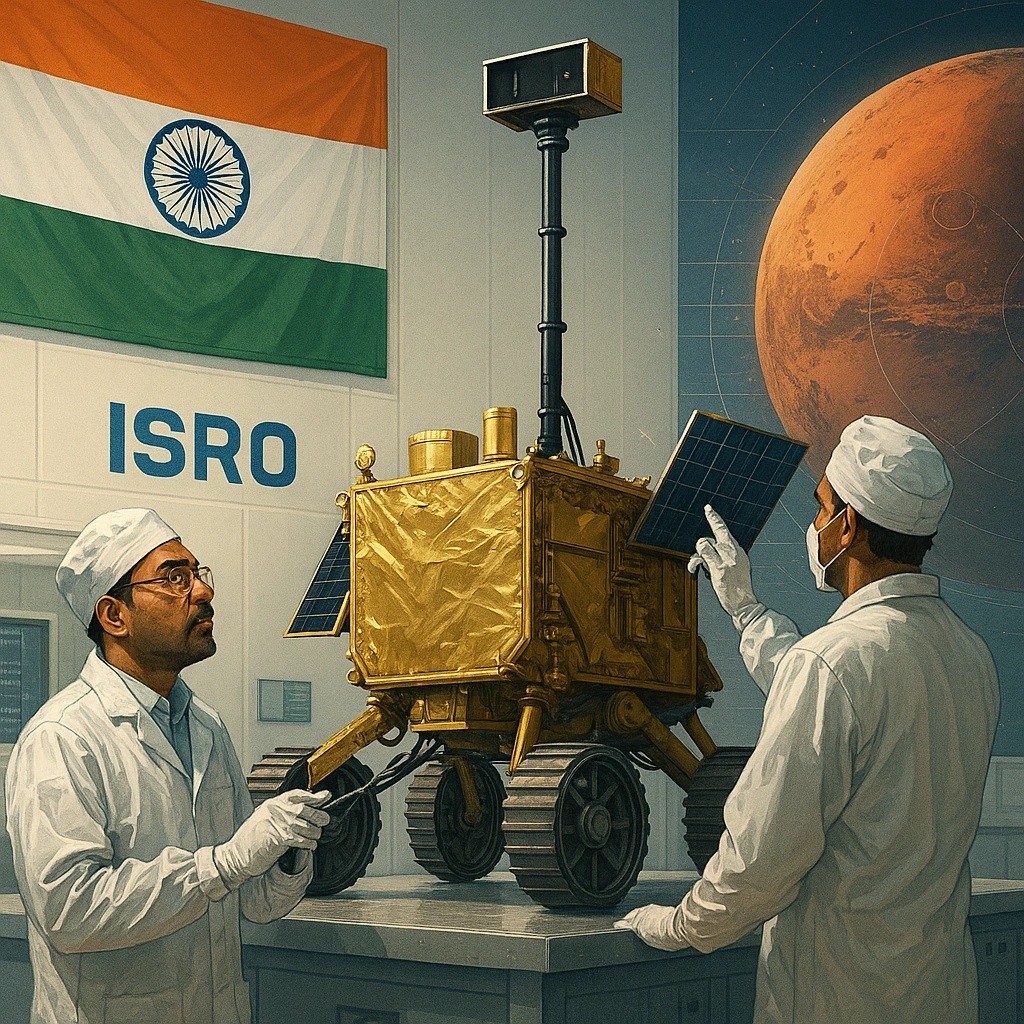Chandrayaan-4 Launch: India’s Quiet Bid to Reach Mars

ISRO engineers finalize rover systems ahead of the Chandrayaan-4 launch, India’s most ambitious Mars mission to date.
Late next year, if all goes to plan, a launch from Sriharikota will attempt something no Indian spacecraft has ever done: land a rover on Mars. It’s not exactly making headlines just yet, but make no mistake—the Chandrayaan-4 launch could end up being one of the biggest moments in India’s space story.
At ISRO’s Bengaluru headquarters, engineers are already working through simulations. The rover’s legs have been redesigned twice. Heat shielding tests are ongoing. No one’s calling it a sure thing—not yet. The risks are real. But so is the ambition.The Chandrayaan-4 Launch isn’t just another space mission—it represents India’s growing ambition to lead in interplanetary exploration. As ISRO gears up for the Chandrayaan-4 Launch, global eyes are on how this mission could lay the groundwork for a future Mars landing. With new technology and a renewed scientific vision, the Chandrayaan-4 Launch signals a quiet but powerful leap forward.
Table of Contents
Mars: Not Just Another Rock
Why is ISRO now looking at Mars, when it only just pulled off a soft landing on the Moon in 2023? The answer is equal parts science, prestige, and momentum. Mars isn’t just another planet—it’s the benchmark. The U.S., China, and a few others have landed probes there. Most have failed. That’s the challenge, and also the appeal.
This mission, however, is more than a red dot on a resume. It aims to land a functioning rover—one that can move, study surface minerals, possibly scan for signs of past life. The Mars Orbiter Mission back in 2014 was about observation from afar. Chandrayaan-4, though it shares the lunar brand name, is going one step closer.
Why Now? Why Us?
Some might wonder if India, with its patchy healthcare system and creaking infrastructure, should be spending hundreds of crores chasing Martian dust. But that’s a question ISRO scientists have fielded for decades. Their answer remains the same: This is not a distraction from development—it’s part of it.
Satellite tech, weather models, communications, crop mapping—it all ties back to what’s learned from these missions. Even so, Chandrayaan-4 launch is not about utility alone. It’s about vision.
China is aggressively expanding its space presence. The US is preparing for manned Mars flybys. For India, waiting another five or ten years would mean falling too far behind to catch up.
And in case anyone forgot, 2026 offers a rare orbital alignment—Earth and Mars will be just close enough for a relatively cost-effective journey. Miss that window, and the next one isn’t until 2028.
A Mission on a Budget
It’s no secret that ISRO doesn’t have NASA’s wallet. The budget for Chandrayaan-4 reportedly hovers around $600 million—roughly one-sixth of what similar U.S. missions cost. But ISRO has built its reputation on frugal ingenuity.
Their engineers often repurpose existing technologies, reduce payload weight, and design modular parts that can be adapted across missions. The Mars Orbiter Mission proved that frugality doesn’t mean failure—it means flexibility.
Of course, this time the stakes are higher. Landing on Mars is a different beast than orbiting it. Thin atmosphere. Harsh terrain. A 14-minute communication delay from Earth. Once the descent begins, there’s no real-time control. The craft has to do it all on its own.
Risk, Uncertainty, and Hope
There’s an old saying among aerospace engineers: “Mars eats spacecraft.” It’s not just poetic. More than half the world’s missions to Mars have ended in silence.
ISRO knows this. They aren’t making grand speeches or flashy documentaries ahead of this one. The tone is sober. Focused. But under that, there’s quiet confidence too. The Chandrayaan-4 launch won’t just be a test of tech—it’ll be a test of temperament.
Because even if this mission fails, it won’t be the end. It will be a data point. A lesson. And knowing ISRO, they’ll pick up the pieces and try again.
You can also read (Urgent Truth: The AI Impact on Global Jobs Is Bigger Than You Think )
The Bigger Picture
What does success look like? If the rover touches down safely and sends back just one week’s worth of data, it will still be a landmark. But success also looks like kids in Lucknow or Coimbatore glued to their screens, cheering as the launch happens. It looks like university labs in Pune tweaking AI models for next-gen rovers. It looks like India being taken seriously in international space dialogues.
There’s already murmuring about collaborations—NASA, ESA, and even JAXA are watching. Private Indian firms, too, are jumping in. Skyroot Aerospace and Agnikul Cosmos—two Hyderabad-based startups—have signed contracts to build small launch vehicles. A thriving space ecosystem is forming, slowly but surely.
And a successful Chandrayaan-4 launch could pour fuel into that fire.
Closing Thoughts
In the grand scheme of things, landing on Mars won’t fix India’s roads or reform its classrooms. But it could do something more subtle—remind a billion people what’s possible when science meets stubborn belief.
This isn’t a moonshot in the metaphorical sense. It’s a real one. A calculated attempt to reach something distant, difficult, and just out of reach.
That, more than anything, is the spirit behind the Chandrayaan-4 launch. And maybe that’s what makes it so worth watching.
You can also read ( Chandrayaan-4 to launch in 2027: Jitendra Singh ) article published by THE HINDUS .







1 thought on “Chandrayaan-4 Launch: India’s Quiet Bid to Reach Mars”